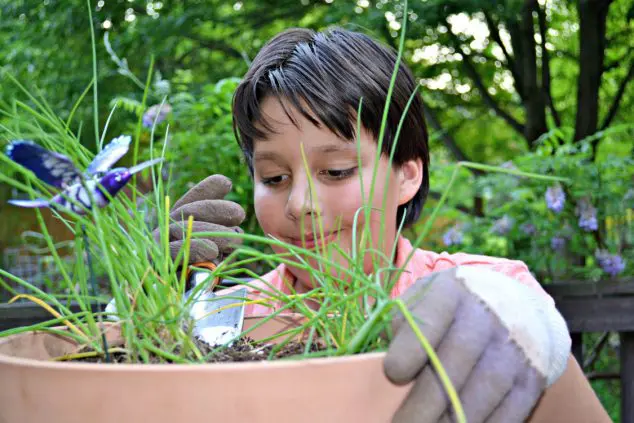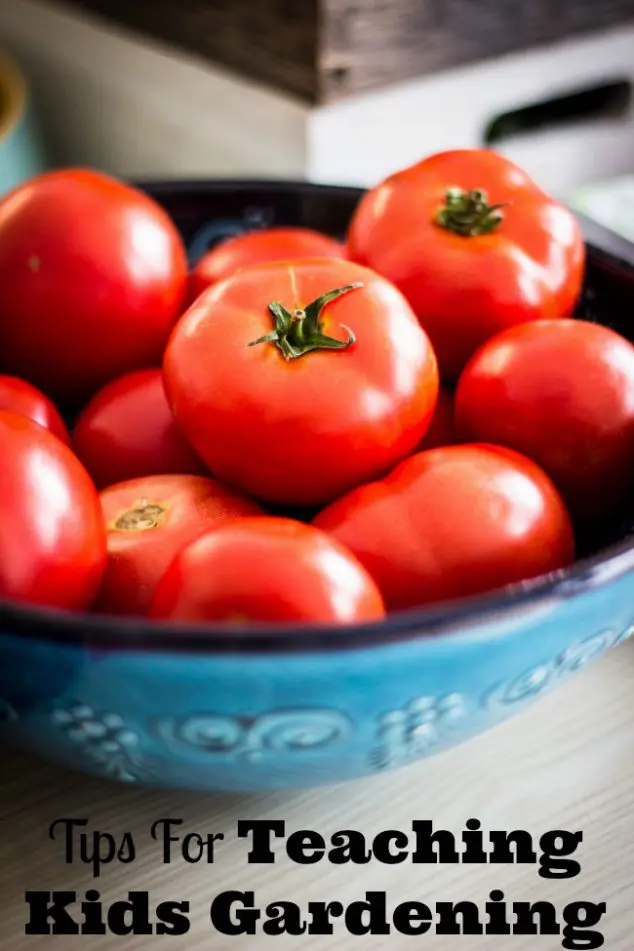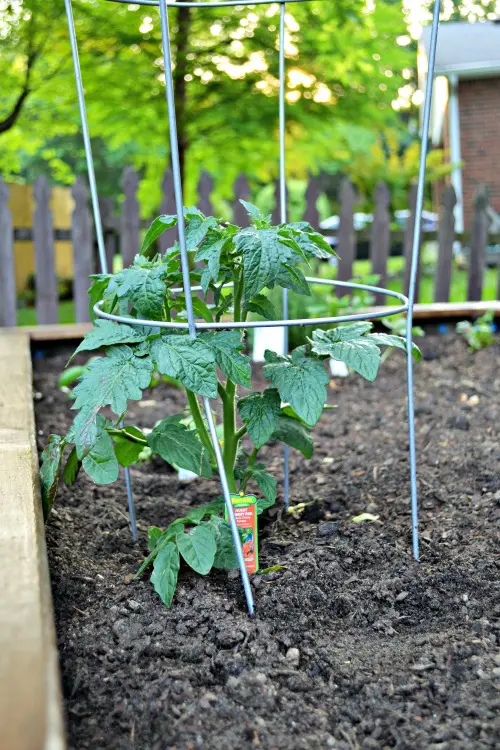The birds are chirping, the grass is growing, and the bees are buzzing; it is time to do some gardening! I don’t think there is anything more satisfying then going out to your own garden and picking your own fruits and vegetables. Gardening is one of my favorite outdoor family activities and it is a great way to get your kids outside and connected with nature. Teaching kids gardening will also open their eyes to where our food comes from, and how it is grown. This article with share what you want to know about gardening- everything from a DIY kids gardening set to tips and tricks to consider when getting started.
Don’t worry if you don’t have a large yard or garden space. Container gardening is a great way to begin gardening with kids. A surprising amount of food can be grown from containers. Tomatoes, cucumbers, peppers, pole beans, herbs and strawberries can all thrive in containers. Buy pots that drain and are at 18 inches in diameter. No matter if you live in the country or in the concrete jungle, your kids can learn a lot about food from the basics of gardening. Sure they can probably help you find the baby carrots or frozen peas in the grocery, but do they know where those carrots and greens really come from? (hint – the answer is not a truck!)
Tricks For Teaching Kids Gardening
Here are three tricks to introduce kids to gardening.
Kids Gardening Set
Before you begin, teach your kids how gardening tools are used. Show them a hoe, shovel, and trowel. Give them a pair of gardening gloves. Explain how each tool works. If you have really young children using a trowel is a perfect option to get them involved. Giving kids a gardening set (affiliate link) is a great way to make them feel vested in the project. Kids love using tools so if they have their own gardening set, they will feel more empowered to play at gardening which is how they build excitement and learn.
A well-meaning child with a garden hose can blast a baby seedling away in a matter of seconds, but you can avoid garden floods by giving your little helper a kid-sized watering can. In addition to the can, consider a child-sized clipper, and a magnifying glass, so then can get in the dirt and get up close and personal with the plants.
Let Kids Get Dirty
Let them get dirty! Show them how to scoop out a space for the plant, then transplant the plant from the pot to container. Explain how the soil needs nutrients, as well as sun and water to help the plants grow.
Let Kids Pick Out Some Plants
Take your child to a garden store and let them pick the out the seeds. Your best bet will be flowers or vegetables with relatively fast germination periods (better for short attention spans). When it comes to flowers, think about easy-to-grow, edible choices. For vegetables, try cherry tomatoes or cucumbers and, for a quick turn around, radishes are perfect.
Let your kids pick out their own plants at the nursery. They will be excited to see the tiny plant they picked out grow to maturity. Buy mostly plants you know your kids will actually eat. Although, having your kids help you grow a food they don’t normally eat can broaden their horizons. Who wouldn’t want to try a new veggie they grew from scratch?
More Tips For Teaching Children How To Garden
Summer is a great time to grow a garden and have your kids help and learn. Studies have shown that when you involve your kids from the ground floor with meals, it encourages them to make healthier choices on their own. Kids are naturally curious. They want to know where their food comes from. Plus, gardening at home with your kids can be a lot of fun for everyone. Here are a few important tricks for teaching kids gardening.
Pick a Small Garden Plot or Get Pots and Containers
You don’t need to live on the farm to enjoy fresh produce and teach your children all about healthy eating. All it takes is a small plot of dirt, or a handful of containers that you can fill with dirt. You can even recycle tin cans or plastic bottles to use as containers if you don’t want to buy terra-cotta pots. Don’t skimp on the dirt. Fill each container nearly to the top or make sure to dig the ground up and break it up to prepare it for planting.
A common mistake beginners make is being too ambitious with their garden plans, only to be discouraged when weeds or bugs take over the plot. Make your project small enough that your child can water it and see everything. Rather than tilling a section of your yard, consider planting in containers, which will help keep weeds at bay and give your child a focus for watering. You can buy pots at a garden store or even use an old sand bucket – just be sure to poke holes for drainage. Containers are great for herbs or patio-type tomatoes but remember if you’re using containers, you may have to water your plants more frequently than if you had planted in the earth. They will dry out faster than plants in the ground.
Place in the Sunshine
Most vegetables need substantial sunshine to grow. This can be as easy as putting your pots on the fire escape, or rooftop if you are in a city. Or it could mean having them on the sunniest side of your house. The same is true for your kids, they need lots and lots of time outside playing and staying active. The plants should get approximately four to six hours of sun a day.
Place Seeds or Young Plants
It is easier to start with small young vegetable plants, than it is to grow an entire plant from a seed. It’s not that it can’t be done, but it requires patience. If it’s your family’s first time, try starting with small pre-grown plants, especially at this point in the summer. Add some good soil to the holes you and your kids have dug in the garden plot or pots and fully cover the roots of the plants.
Water Every Day
Just as water is the healthiest option for you and your family to drink, it is a vital necessity for fruits and vegetables to grow. Make sure you water your plants every day. An important element of teaching kids gardening is having them help keep the plants hydrated and weeded.
Experiment
Some of your plants might grow like weeds, others might be stomped out by weeds. The key is to figure out, along with your child, what works and what doesn’t. A garden can become a living science experiment, where they can compare what happens when one seedling receives fertilizer or water or sunlight and when one doesn’t. Not everything will grow in the way you expect, and that’s okay. Don’t be afraid to fail.
Gardening shouldn’t feel like a chore, so don’t treat it like one. Instead of saying to your child to “let’s go work in the garden” try asking them if they want to go “peek under the leaves” to see what they might find. Discovering the beginning of a pepper or an onion sprig is a really cool thing! Recognize and celebrate milestones in the garden, such as the first sprout or the first flower. Positive reinforcement encourages continued interest in gardening.
Watch Your Vegetables Grow!
Little do they know that while they’ve been helping you along in the process of digging, planting, weeding and watering; that the whole time the television has been off and they’ve been burning calories. Let your kids do most of the work. Watch their satisfaction grow as they cultivate their own tomatoes, peppers, lettuces, and carrots. Make sure you stake or trellis the plants to allow them to be productive.
Let Kids Harvest
Once the plants begin producing, kids can harvest the fruits and veggies. Toss a salad and teach them how to make an easy vinaigrette and have them enjoy the fruits (and vegetables) of their labors. They can help you prepare recipes using produce they have grown. Or they can snack on strawberries and cherry tomatoes straight off the bush. Yummy! This can be a rewarding experience.
No Outdoors? No Problem
Not everyone has access to an outdoor garden space, but apartment dwellers and others with limited outdoor space can still develop a serious green thumb by focusing on indoor plants. Try the afore mentioned potted tomato or even try planting aloe vera, which grows easily and can be used to treat household burns. And if all else fails, just visit a local pick-your-own farm where kids can see the real deal in action!
Conclusion
Remember to adapt the gardening activities to the age and interests of the children involved. Gardening with kids can be a memorable and enriching experience for both adults and youngsters alike. There are many benefits to gardening with kids. Gardening teaches kids about seasonal fruits and the benefits of vegetables. They learn to discern quality produce. What is tasty in Spring won’t even grow in grow in Autumn. Try to have a taste-test with them to see if they can tell the difference between store-bought or home-grown. I’ll bet they can tell what they have grown any day of the week.
Don’t forget to invest in smaller, lightweight gardening tools designed for children. This makes it easier for them to handle and participate in the gardening process. Gardening can be a wonderful and educational activity for kids. It not only teaches them about nature and the environment but also instills a sense of responsibility and patience. Happy planting! I hope your family enjoys this growing season.
Related Posts:




KMV says
Kids can learn to love gardening as they watch their plants grow. It also helps connect them with the earth and understand that food comes from the ground after hard work (as opposed to just coming from a store). We like to use an indoor grower for the cold months, and the kids love watching their plants grow. It’s also more eco-friendly than buying herbs and food that was grown a long ways away.